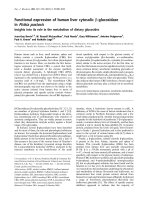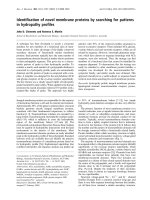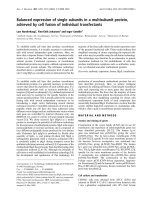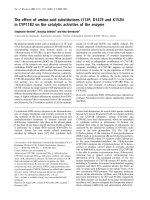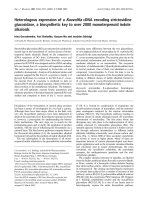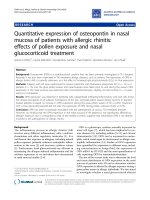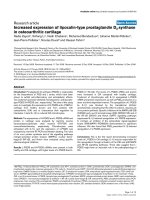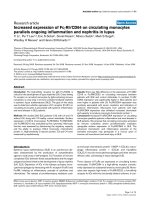Báo cáo y học: "Divergent expression of claudin -1, -3, -4, -5 and -7 in developing human lung" potx
Bạn đang xem bản rút gọn của tài liệu. Xem và tải ngay bản đầy đủ của tài liệu tại đây (2.77 MB, 10 trang )
Kaarteenaho et al. Respiratory Research 2010, 11:59
/>Open Access
RESEARCH
BioMed Central
© 2010 Kaarteenaho et al; licensee BioMed Central Ltd. This is an Open Access article distributed under the terms of the Creative Com-
mons Attribution License ( which permits unrestricted use, distribution, and reproduc-
tion in any medium, provided the original work is properly cited.
Research
Divergent expression of claudin -1, -3, -4, -5 and -7
in developing human lung
Riitta Kaarteenaho*
1,2
, Heta Merikallio
1
, Siri Lehtonen
3
, Terttu Harju
2
and Ylermi Soini
4
Abstract
Background: Claudins are the main components of tight junctions, structures which are associated with cell polarity
and permeability. The aim of this study was to analyze the expression of claudins 1, 3, 4, 5, and 7 in developing human
lung tissues from 12 to 40 weeks of gestation.
Methods: 47 cases were analyzed by immunohistochemisty for claudins 1, 3, 4, 5 and 7. 23 cases were also investigated
by quantitative RT-PCR for claudin-1, -3 and -4.
Results: Claudin-1 was expressed in epithelium of bronchi and large bronchioles from week 12 onwards but it was not
detected in epithelium of developing alveoli. Claudin-3, -4 and -7 were strongly expressed in bronchial epithelium from
week 12 to week 40, and they were also expressed in alveoli from week 16 to week 40. Claudin-5 was expressed
strongly during all periods in endothelial cells. It was expressed also in epithelium of bronchi from week 12 to week 40,
and in alveoli during the canalicular period. RT-PCR analyses revealed detectable amounts of RNAs for claudins 1, 3 and
4 in all cases studied.
Conclusion: Claudin-1, -3, -4, -5, and -7 are expressed in developing human lung from week 12 to week 40 with
distinct locations and in divergent quantities. The expression of claudin-1 was restricted to the bronchial epithelium,
whereas claudin-3, -4 and -7 were positive also in alveolar epithelium as well as in the bronchial epithelium. All claudins
studied are linked to the development of airways, whereas claudin-3, -4, -5 and -7, but not claudin-1, are involved in the
development of acinus and the differentiation of alveolar epithelial cells.
Introduction
During lung ontogenesis, the conducting airways are
quite early lined by epithelium which consists of ciliated,
secretory, intermediate and basal cells [1,2]. The epithe-
lium of distal lung including type I and II pneumocytes
and Clara cells lining the walls of respiratory bronchioles
and alveoli, differentiate later than the cells of the con-
ducting airways [3]. Epithelial cell differentiation is
closely connected to the changes in the extracellular
matrix and its proteins which are expressed in varying
amounts and in distinct locations during human lung
development [4,5].
Epithelial and endothelial cells interact with neighbour-
ing cells through various kinds of cell-cell communica-
tion systems, such as tight, gap and adherens junctions.
All types of junctions exist in lung epithelium, but knowl-
edge of their development, exact function and distribu-
tion in the developing and adult human lung is
incomplete. It was discovered less than a decade ago that
the claudin family which nowadays contains 24 members,
are proteins that make up the tight junctions [6]. Epithe-
lial cells often express multiple claudin types, and they
show a variable expression profile in different epithelia
[7]. Similarly, expression of different claudins varies
between different types of epithelial, endothelial and
mesothelial tumors [8,9]. A mutation of claudin-16 is
associated with a rare autosomal-recessive renal disorder,
familial hypomagnesemia with hypercalciuria and neph-
rocalcinosis [10] and that of claudin-14 with deafness
[11].
Expression of various claudins in the tissue of develop-
ing rat lung and in cultured fetal human lung cells has
been previously documented [12,13]. Connexin 26, which
is an element of the gap junctions, has been shown to be
expressed in developing and adult human lung tissues
[14]. Studies on the expression of claudins in different
* Correspondence:
1
Institute of Diagnostics, Department of Pathology and Clinical Research
Center , University of Oulu, Oulu, Finland
Full list of author information is available at the end of the article
Kaarteenaho et al. Respiratory Research 2010, 11:59
/>Page 2 of 10
kinds of lung carcinomas and in human fibrotic lung dis-
orders have been published [15-17]. Our previous study
showed that in normal human adult lung, claudin-1, -2, -
3, -4, -5 and -7 were expressed in the epithelium of bron-
chioles, whereas claudin-3, -4 and -7 were only located in
type II pneumocytes in alveoli [18]. Claudin-5 is the only
member of the claudin-family which is known to be
expressed in endothelial cells [19]. Endothelial VE-cad-
herin at adherent junctions has been demonstrated to
upregulate the gene encoding the tight junction adhesive
protein claudin-5 [20]. So far there are no published stud-
ies on the expression of claudins in normal human devel-
oping lung at the tissue level.
Our aim was to study the expression and cell-specific
localization of five different types of claudin, namely clau-
din -1, -3, -4, -5, and -7, in normal human developing
lung at different gestational ages i.e. from week 12 to
week 40 during the pseudoglandular, canalicular, saccular
and alveolar periods. We hypothesized that the expres-
sion of the different claudins during ontogenesis of
human lung might vary since they have distinct expres-
sion profiles in normal human lung.
Materials and methods
Patients and handling of specimens
Samples of lung tissue were retrieved from the files of the
Department of Pathology, Oulu University Hospital. The
study protocol was approved by the Ethical committee of
the local hospital and the National Supervisory Authority
for Welfare and Health. The study material for developing
lung consisted of 47 cases of spontaneous abortion, still-
birth, and autopsied infants who had died for different
reasons without lung disorders within 1-2 days after birth
at the Oulu University Hospital between 1990 and 2002.
Autopsies have been performed within the first day in
most cases and within two days in 4 cases. The cause of
death of the infants were abortion (n = 19), abruption of
placenta (n = 9), rupture of fetal membranes (n = 2), feto-
fetal transfusion (n = 2), sacral teratoma (n = 2), prolapse
or aplasia of the umbilical artery (n = 3), placentitis or
chorioamnionitis (n = 4), hemochromatosis (n = 1),
hydrocephalus (n = 1), meningomyelocele (n = 1),
encephalocele (n = 1), holoprosencephaly (n = 1) and
hemorrhage of caput (n = 1). Infants with pneumonia,
cardiac abnormalities or features of maceration were
excluded. The gestational age of infants ranged from 12
to 40 weeks, corresponding to the pseudoglandular (day
52 to week 16, 13 cases), canalicular (weeks 16-28, 17
cases), saccular (weeks 28-36, 9 cases) and alveolar
(weeks 36-40, 8 cases) periods. The clinical information
was obtained from the patient records.
Lung samples, which had been taken from different
parts of the left or right lung were fixed in 10% formalin
and then dehydrated and embedded in paraffin. Sections
5 μm thick were stained with hematoxylin-eosin. All
material was re-evaluated, and one representative tissue
block from each case was selected for the immunohis-
tochemical studies.
Antibodies and immunohistochemical staining
The primary antibodies used for immunohistochemistry
were all purchased from Zymed Laboratories Inc. (South
San Fransisco, CA, USA) and designed to be used in for-
malin-fixed paraffin-embedded tissues. They were poly-
clonal rabbit anticlaudin 1 (clone JAY.8), polyclonal rabbit
anticlaudin 3 (clone Z23.JM), monoclonal mouse anti-
claudin 4 (clone 3E2C1), monoclonal mouse anticlaudin 5
(clone 4C3C2) and polyclonal rabbit anticlaudin 7 (clone
ZMD.241). Before application of the primary antibodies,
the sections were heated in a microwave oven in 10 mM
citrate buffer, pH 6.0, for 10 min. After a 60-min. incuba-
tion with the primary antibody (dilution 1:50 for anticlau-
dins 1, 3, 4, 5 and 7), a biotinylated secondary anti-rabbit
or anti-mouse antibody and the Histostain-SP kit (Zymed
Laboratories) were used. In all the immunohistochemical
evaluations, the colour was developed by diaminobenzi-
dine and, subsequently, the sections were lightly counter-
stained with haemotoxylin and mounted with Eukitt
(Kindler, Freiburg, Germany).
Negative controls were obtained by substituting non-
immune rabbit or mouse serum and PBS for the primary
antibodies.
Scoring of the immunoreactivity
The extent and intensity of various claudins were evalu-
ated semiquantitatively as negative (0), weak (+), moder-
ate (++) or strong (+++) in different types of pulmonary
cells, such as epithelial cells of bronchioles and bronchus,
alveolar epithelium including pretype II cells, type I and
II pneumocytes, endothelial cells, interstitial cells such as
fibroblasts and myofibroblasts, and mesothelial cells. In
the evaluation, membrane-bound positivity was consid-
ered as significant.
Quantitative real-time reverse transcriptase polymerase
chain reaction (RT-PCR)
In 23 cases representing all developmental periods
(pseudoglandular, n = 4; canalicular, n = 8; saccular, n = 7;
alveolar, n = 4) one tissue block was selected for quantita-
tive real-time reverse transcriptase polymerase chain
reaction (RT-PCR) analyses for claudin-1, -3 and -4. As it
has been shown previously that RNA can isolated from
paraffin embedded tissue material for expression profil-
ing [21,22] the total RNA was isolated from five 10 μm
thick slices from each sample with Purelink FFPE total
RNA isolation kit according to the manufacturer's
instructions (Invitrogen, Carlsbad, CA, USA). The iso-
lated RNA was quantified and qualified spectrophoto-
metrically and 0.5 μg of total RNA was converted to
Kaarteenaho et al. Respiratory Research 2010, 11:59
/>Page 3 of 10
cDNA by RevertAid first strand cDNA synthesis kit (Fer-
mentas, EU). Real Time PCR was performed with 5 μl
cDNA template in a total volume of 25 μl, using the iQ5
Optical system (Bio-Rad Laboratories, Hercules, CA).
The DNA- binding dye used in RT-PCR was SYBR Green
I (iQ Custom SYBR green supermix, Bio-Rad Laborato-
ries) which binds non-specifically to double-stranded
DNA and the amount of bound dye was measured at each
amplification cycle in a real time manner. RT-PCR reac-
tions were performed in duplicate in 96-well plates.
Cycling conditions were: at 95°C for three minutes, 40
cycles of amplification (each 95°C for 10 seconds and
56°C for 30 seconds), one minute at 95°C, one minute at
55°C and melt data acquisition. Primer sequences are
shown in Table 1. The RT-PCR results of developing lung
samples were compared to a lung sample of a normal
human adult lung that was set to value 1 for each claudin
separately. The relative quantities were calculated by Bio-
Rad iQ5 standard edition optical system software version
2.0 by ΔΔC
T
method [23]. GAPDH was considered as a
reference gene and a sample of normal adult lung as a ref-
erence sample. The mean values and standard deviations
were calculated for pseudoglandular, canalicular, saccular
and alveolar periods and the results were analysed statis-
tically by Kruskal Wallis test.
Results
Immunohistochemistry
Pseudoglandular period (weeks 12 to 16)
During the pseudoglandular period, the airways are sub-
dividing (i.e. branching morphogenesis). The airways
form round gland-like structures, which are lined by
pseudostratified epithelia and separated by cellular mes-
enchymes. Claudin-1 was expressed mainly weakly in
bronchi and in some cases also in the larger bronchioles,
but it was not detected in small developing airways (Fig
1A). Claudin-3 was expressed strongly in bronchi, and
moderately or weakly in bronchioles and small develop-
ing airways, which were all positive for claudin-3 (Fig 1B,
1C). Claudin-4 was strongly positive in bronchi, whereas
in bronchioles and small developing airways, it was
scored as moderate or weak (Fig 1D, 1E). Claudin-5 was
strongly positive in endothelial cells, and it was also
weakly positive in bronchi, bronchioles and small devel-
oping airways (Fig 1F). Claudin-7 was strongly positive in
the epithelium of bronchi and bronchioles, and it was also
weakly or moderately positive in small developing air-
ways (Fig 1G). During the pseudoglandular period all epi-
thelial cells were positive for claudin-3, -4 and -7 in
contrast to claudin-1, which was restricted mainly to the
bronchi.
Canalicular period (weeks 16 to 28)
The airways are dividing further, the vascular system is
developing, and the amount of mesenchyme is decreas-
ing. The epithelium becomes thinner. From week 16, pre-
type II cells appear, and from weeks 24 to 28, type I and
type II pneumocytes start to be detected. The airways are
mostly simple and numerous, but in their midst, one can
also find branching airways. Claudin-1 was expressed
moderately or strongly in the epithelium of bronchi and
bronchioles, whereas alveolar epithelium was negative
(Fig 2A). Claudin-3, claudin-4 and claudin-7 were
expressed positively in alveolar epithelium i.e. in pretype
II cells, and the epithelia of bronchi and bronchioles were
also strongly positive (Fig 2B, 2C, 2D, 2E, 2G). Claudin-5
was strongly positive in endothelial cells. In addition to
the endothelial positivity, it was also weakly positive in
epithelium of bronchi and bronchioles, and clearly posi-
tive within alveoli in pretype II cells (2F).
Saccular (weeks 28 to 36) and alveolar (weeks 36 to 40)
periods
The saccular and alveolar periods are characterized by an
increase in the gas-exchanging surface area, and a
decrease of the mesenchymes between saccules. Small
crests appear in the walls of sacculi, ultimately developing
into alveoli from week 36 onward. Claudin-3, -4 and -7,
but not claudin-1 and -5, were positive in type II pneu-
mocytes (Fig 3A-3G, 4A-4G). Claudin-1, -3, -4 and -7
were expressed strongly in bronchi and bronchioles (Fig
3G, 4C, 4D, 4G). Claudin-5 positivity was strong in
endothelial cells of arteries, capillaries, veins and lym-
phatic vessels, whereas bronchial epithelium displayed
faint positivity and alveolar epithelium remained negative
(Fig 3F, 4F).
Mesothelium, fibroblasts, myofibroblasts, smooth mus-
cle cells and chondrocytes were negative for all of the
claudins studied. In some cases during the pseudoglandu-
lar period, trachea was included within the tissue sample,
and its epithelium was positive for all claudin studied.
Table 1: Sequences of primers used for qRT-PCR.
Target Reverse primer (5'-3')Forward primer (5'-3')
GAPDH GAGTCAACGGATTTGGTCGT GACAAGCTTCCCGTTCTCAG
claudin 1 CCGGCGACAACATCGTGAC CGGGTTGCTTGCAATGTGC
claudin 3 CGCGAGAAGAAGTACACGG CCTTAGACGTAGTCCTTGCGG
claudin 4 CGCATCAGGACTGGCTTTATCTC CAGCGCGATGCCCATTA
Kaarteenaho et al. Respiratory Research 2010, 11:59
/>Page 4 of 10
The results of the scoring of the immunoreactivity of
various claudins are shown in Table 2. The exact scores of
each case for each claudin in various periods are repre-
sented.
RT-PCR To tal R N A was i solated from paraffin embed-
ded tissues and converted to cDNA. Relative quantity of
claudins 1, 3 and 4 were studied by RT-PCR. The results
of the RT-PCR assays demonstrated that it was possible
to isolate RNA fragments large enough for amplification
from each sample. Minor differences could be detected
between the samples in the RNA amount of GAPDH that
can be considered as a house-keeping gene as there were
no statistically significant differences between various
gestational stages.
Quantity of each claudin was related separately to adult
lung sample (value = 1) and therefore the values are rela-
tive and the values of different claudins are not compara-
ble. For example the values of claudin-1 can be compared
only to other values of claudin-1, but not to claudin-3 or -
Figure 1 Immunohistochemical staining for claudins 1, 3, 4, 5 and
7 in pseudoglandular period i.e. in weeks 12-16 in developing hu-
man lung. 1A. Epithelium of a bronchus is positive for claudin-1 (ar-
row). The short arrow is indicating the cartilage of the bronchus. Scale
bar = 80 μm. 1B. Epithelial cells of developing bronchioles are positive
for claudin-3 (arrows). Scale bar = 80 μm. 1C. Strong positivity for clau-
din-3 is seen in the epithelial cells of a bronchiole. Scale bar = 25 μm.
1D-1E. Epithelium of bronchioles is strongly positive for claudin-4 (ar-
rows). Scale bar = 80 μm in Fig 1D, scale bar = 25 μm in Fig 1E. 1F. En-
dothelial (short arrow) and epithelial cells (arrow) of bronchial
epithelium are positive for claudin-5. Scale bar = 80 μm. 1G. Epithelium
of bronchi and developing airways are positive for claudin-7 (arrow).
Scale bar = 80 μm. 1H. Negative control in which the primary antibody
has been substituted with non-immune rabbit mouse serum. Scale bar
= 80 μm.
Figure 2 Immunohistochemical staining for claudins 1, 3, 4, 5 and
7 in the canalicular period i.e. weeks 16-28. 2A. Epithelial cells in-
cluding pretype II cells of developing alveoli are negative for claudin-1.
Scale bar = 80 μm. 2B. Positive immunoreactivity for claudin-3 is ob-
served in the epithelial cells of a bronchiole (on the left) and in the pre-
type II cells of developing alveoli. Scale bar = 80 μm. 2C. Pretype II cells
of developing alveoli are positive for claudin-3 (arrow). Scale bar = 25
μm. 2D-2E. Epithelium of a bronchiole (short arrow in the Fig 2D) and
pretype II cells lining alveoli (arrows in the Figs 2D and 2E) are positive
for claudin-4. Scale bar = 80 μm in the Fig 2D, scale bar = 25 μm in the
Fig 2E. 2F. Endothelial cells of alveolar capillaries (arrow) and an artery
(arrowhead), pretype II cells lining alveoli (asterisk) and epithelium of
bronchioles (short arrow) are positive for claudin-5. Scale bar = 80 μm.
2G. Alveolar (arrows) and bronchiolar epithelium (short arrow) are pos-
itive for claudin-7. Scale bar = 80 μm. 2H. Negative control in which the
primary antibody has been substituted with PBS with haematoxylin
counterstain. Scale bar = 80 μm.
Kaarteenaho et al. Respiratory Research 2010, 11:59
/>Page 5 of 10
4. Variable amount of RNAs of claudin-1 (Fig 5A), clau-
din-3 (Fig 5B) and claudin-4 (Fig 5C) were detected. Clau-
din-1 RNA level was low (mean 0.60, SD 0.47) at week 12
to week 16 increasing (p = 0.016) slightly after week 20
(mean 9.98, SD 21.55) (Fig 6). The expression of claudin-1
RNA was further increased during saccular (mean 25.25,
SD 37.81) and alveolar periods (mean 27.95, SD 31.82).
RNA-expression of claudin-3 was low during
pseudoglandular period (mean 4.18, SD 2.05) and
increased (p = 0.048) towards the canalicular period
(mean 11.31, SD 6.70) after which it decreased in saccular
(mean 3.65, SD 2.61) and alveolar (mean 3.65, SD 2.61)
periods. RNA level of claudin-4 appeared to increase
from pseudoglandular period (mean 2.21, SD 1.04) to
canalicular period (mean 4.17, SD 2.85) when its level was
at its highest. Subsequently, expression of claudin-4 RNA
was observed to decline in saccular period (Mean 2.49,
SD 0.87) and it then appeared to stay at that level until
week 42 (mean 3.53, SD 1.83). Amounts of RNAs of clau-
dins 1, 3 and 4 were slightly higher in the end of alveolar
period of developing lung than in healthy adult human
lung.
Figure 3 Immunohistochemical staining for claudins 1, 3, 4, 5 and
7 in the saccular period i.e. weeks 28-36. 3A. Alveolar epithelium is
negative for claudin-1. Scale bar = 80 μm. 3B-C. Type II pneumocytes of
developing alveoli are positive for claudin-3 (arrows). Scale bar = 80 μm
in the Fig 1B, scale bar = 25 μm in the Fig 1C. 3D. Type II pneumocytes
lining alveoli are positive for claudin-4 (arrow). Scale bar = 80 μm. 3E.
Endothelial cells of capillaries (arrow) and an artery (arrowhead), and
also epithelium of a bronchiole (short arrow) are positive for claudin-5.
Scale bar = 80 μm. 3F. Strong immunoreactivity for claudin-5 is seen in
endothelial cells of an artery (arrow). Scale bar = 25 μm. 3G. Type II
pneumocytes of alveoli (arrow) and epithelial cells of a bronchiole
(short arrow) are expressing claudin-7. Scale bar = 80 μm. 3 H: Negative
control in which the primary antibody has been substituted with non-
immune rabbit mouse serum. Scale bar = 80 μm.
Figure 4 Immunohistochemical staining for claudins 1, 3, 4, 5 and
7 in the alveolar period i.e. weeks 36-40. 4A-4B. Epithelium of alveoli
is negative for claudin-1. Scale bar = 80 μm in the Fig 4A, scale bar = 25
μm in the Fig 4B. 4C, 4D, 4E: Type II pneumocytes of alveoli (arrows) and
epithelium of bronchioles (short arrows) are positive for claudin-3 (4C)
and claudin-4 (4D, 4E). Scale bar = 80 μm in the Figs 4C and 4 D, scale
bar = 25 μm in the Fig 4E. 4F. Endothelial cells of alveolar capillaries (ar-
row) and an artery (arrowhead), and bronchiolar cells (short arrow) are
positive for claudin-5, whereas alveolar epithelium is not. Scale bar =
80 μm. 4G: Epithelium of a bronchiole (short arrow) and type II pneu-
mocytes of alveoli (arrow) are positive for claudin-7. Scale bar = 80 μm.
4H. Negative control in which the primary antibody has been substi-
tuted with PBS with haematoxylin counterstain. Scale bar = 80 μm.
Kaarteenaho et al. Respiratory Research 2010, 11:59
/>Page 6 of 10
Table 2: Immunoreactivity scores for claudin-1, -3, -4, -5 and-7 in different types of pulmonary cells in developing human
lung during various gestational periods.
Claudin type Pseudo-glandular
period
day 52-week 16
13 cases
(scores/number of
cases)
Canalicular period
weeks 16-28
17 cases
(scores/number of
cases)
Saccular period
weeks 28-36
9 cases
(scores/number of
cases)
Alveolar period
weeks 36-40
8 cases
(scores/number of
cases)
Claudin-1
bronchus +/10, ++/3 +++/17 ++/8, +++/1 ++/1, +++/7
bronchioles +/5, ++/12 +/8, ++/1 ++/5, +++/3
- large +/13
- small negative/13
alveolus # negative/13 negative/17 negative/9 negative/8
endothelial cell negative/13 negative/17 negative/9 negative/8
Claudin-3
bronchus +++/13 +++/17 +++/9 +++/8
bronchiolus ++/6, +++/7 +++/17 +++/9 +++/8
alveolus # +/4, ++/9 * +/8, ++/9 & +/7, ++/2 & +/7,++/1
endothelial cell negative/13 negative/17 negative/9 negative/8
Claudin-4
bronchus +++/13 +++/17 +++/9 +++/8
bronchiolus +++/13 +++/17 +++/9 +++/8
alveolus # +/3, ++/10 * +/4, ++/13 & +/5 ++/4 & +/2 ++/6
endothelial cell negative/13 negative/17 negative/9 negative/8
Claudin-5
bronchus +/13 +/17 +/9 +/8
bronchiolus +/13 +/17 +/9 +/8
alveolus # +/13 * +/17 negative/9 negative/8
endothelial cell +++/13 +++/17 +++/9 +++/8
Claudin-7
bronchus +++/13 +++/17 +++/9 +++/8
bronchiolus ++/3, +++/10 +++/17 +++/9 +++/8
alveolus # +/13 * +/7,++/9, +++/1 & +/8, ++/1 & +/8
endothelial cell negative/13 negative/17 negative/9 negative/8
# = small developing airways, not alveoli
* = pretype II cells
& = type II pneumocytes
Kaarteenaho et al. Respiratory Research 2010, 11:59
/>Page 7 of 10
Figure 5 Quantitative RT-PCR analysis of claudin-1 (5A), claudin-3 (5B) and claudin-4 (5C) expression of RNA isolated from paraffin embed-
ded lung tissue samples. Each bar represents a single lung sample from weeks 13 to 42 related to adult lung (value = 1). The analyses show a great
individual variability in the expression of all claudins analysed. Expression of claudin-1 RNA increases towards the end of gestation, whereas RNA ex-
pressions of claudin-3 and -4 are at their highest in the canalicular period.
0
20
40
60
80
100
Adult*41 424039
35
3535303028282626242322202020
16
1613
Relative Expression of Claudin 1
Weeks
13
0
5
10
15
20
25
Relative Expression of Claudin 3
Weeks
Adult*41 424039
35
3535303028282626242322202020
16
1613
13
0
2
4
6
8
Relative Expression of Claudin 4
Weeks
Adult*41 424039
35
3535303028282626242322202020
16
1613
13
A
B
C
Kaarteenaho et al. Respiratory Research 2010, 11:59
/>Page 8 of 10
Figure 6 Summary of the quantitative RT-PCR results showing the ex-
pression of claudin-1 (A), claudin-3 (B) and claudin-4 (C) in various ges-
tational stages. Results are shown as mean values and error bar represents
the standard deviation.
Discussion
This is the first study to demonstrate the expression
and cell-specific localization of claudin-1, -3, -4, -5
and -7 in developing human lung at the tissue level.
We observed that the expression of claudin-1 was
more restricted compared to the other claudins stud-
ied, since it was positive only in the epithelium of
bronchi and bronchioles, but not in the alveolar epi-
thelium. In a previous study by Wang et al on develop-
ing rat lung tissue claudin-3, -4 and -5 were co-
expressed in type II alveolar epithelial cells, but only a
trace amount of claudin-1 could be detected in these
cells, a finding which is in line with our present study
[24]. Similar to our findings claudin-5 was expressed
throughout the alveolus [13], although our study clari-
fied that the expression of claudin-5 was due to its
presence in alveolar endothelial cells. The study of
Daugherty and co-authors indicated that fetal lung
cells cultured in a medium containing elements which
promoted alveolar epithelial cell differentiation to a
type II phenotype expressed claudin-1, -3-, -4, -5 and -
7 [25]. This finding is in concordance with ours except
for claudin-1. The difference may be due to different in
vitro methodology using experimentally manipulated
fetal lung cells. We also observed a distinct expression
profile of claudins in bronchial cells. Claudin-1 was
expressed later in gestation i.e. it was negative in the
small sized developing airways during the pseudo-
glandular period. In contrast these airways were
clearly positive for claudin-3, -4 and -7 and faintly pos-
itive for claudin-5 during that period. The most abun-
dant expression of claudins by immunohistochemistry
was observed during the canalicular period from week
16 to week 28, when alveoli and acini are developing.
The cells that line the alveoli during most of that
period are pretype II pneumocytes, which are devel-
oping into type II pneumocytes and type I pneumo-
cytes during weeks 24-28. Claudin-3, -4, -5 and -7
were positive in pretype II cells during the canalicular
period, while later during the saccular and alveolar
phases from week 28 to week 40 only claudin-3, -4 and
-7 were present in type II pneumocytes, and claudin-5
was not expressed any longer in these cells.
During the pseudoglandular period when terminal
bronchioli are developing, claudin-3, -4 and -7 were
positive in all epithelial cell-lining airways, but clau-
din-1 was positive mainly in large bronchi and its
expression was usually quite weak. Claudin-3, -4, -5
and -7 were positive and claudin-1 negative in pretype
II cells of alveoli during the canalicular period indicat-
ing that claudin-3, -4 and -7, but not claudin-1, are
related to the development of acini and the differentia-
Kaarteenaho et al. Respiratory Research 2010, 11:59
/>Page 9 of 10
tion of alveolar epithelial cells. In our previous study with
samples from normal human adult lung, sarcoidosis and
idiopathic pulmonary fibrosis (IPF) claudin-3, -4 and -7,
but not claudin-1, were positive in normal type II pneu-
mocytes, a finding which is in agreement with the results
of the present study [26]. Claudin-1 was, however,
detected in the metaplastic alveolar epithelium of IPF and
sarcoidosis. Claudin-5 was mainly positive in the
endothelial cells of adult human lung, sarcoidosis and IPF,
but it was also faintly positive in the bronchial and meta-
plastic alveolar epithelium of the diseased lung, a finding
which is confirmed by the results of the present study
demonstrating epithelial expression in the developing
bronchial epithelium and in the alveoli during the canali-
cular period.
In our previous studies with a similar material, we
investigated the expression of tenascin-C, collagen I and
collagen III mRNAs in developing human lung [4,5,27].
Some mRNAs are stable for 24 hours under post-mortem
conditions, allowing in situ hybridization to be per-
formed [28]. In the present study, the results of immuno-
histochemistry were confirmed by RT-PCR. This method
detected measurable amounts of claudin-1, claudin-3 and
claudin-4 mRNAs in all 23 cases studied. The amount of
claudin-1 mRNA was low during the pseudo-glandular
period, a finding which is concurrent with the results of
immunohistochemistry. Furthermore, the mRNAs of
both claudin-3 and claudin-4 were at their highest during
the canalicular period, a finding which is also in concor-
dance with the results obtained by immunohistochemis-
try, since during the canalicular period, the expressions of
claudin-3 and -4 were positive both in bronchioles and
alveoli. During the canalicular period all pretype II cells
were positive for claudin-3 and -4, but negative for clau-
din-1. The decrease in the amounts of the mRNAs coding
for claudin-3 and -4 after the canalicular period is attrib-
utable to the development of type I and type II pneumo-
cytes during the saccular and alveolar periods since type I
pneumocytes are negative for claudin-3 and -4. With the
prospective procedure and a standardized fixation time,
it might be possible to achieve even more accurate infor-
mation about the amounts of mRNA of different clau-
dins.
We conclude that claudin-1, -3, -4, -5, and -7 are
expressed in developing human lung from week 12 to
week 40 with distinct locations and in divergent quanti-
ties reflecting changes in cellular polarity and permeabil-
ity during different phases of epithelial development. The
expression of claudin-1 is restricted to the bronchial epi-
thelium, whereas claudin-3, -4 and -7 are positive also in
alveolar epithelium as well as in bronchial epithelium
suggesting that these claudins in contrast to claudin-1 are
also involved in the development of acinus and the differ-
entiation of alveolar epithelial cells. Claudin-5 is localized
mainly in endothelial cells but its expression in pretype II
alveolar epithelium indicates that it may be involved in
the development of acinar epithelial cells.
Competing interests
The authors declare that they have no competing interests.
Authors' contributions
RK participated in the design of the study, collected the study material, ana-
lyzed the immunohistochemical and clinical data of the patients, and drafted
the manuscript. HM participated in the study by carrying out the quantitative
RT-PCR analysis, created the RT-PCR figures and helped to draft the manuscript.
SL participated in design of the study, design and analysis of RT-PCR-analyses
and helped to draft the manuscript. TH participated in design of the study,
design of RT-PCR-analyses and helped to draft the manuscript. YL participated
in design of the study and helped to draft the manuscript. All authors has read
and approved the final manuscript
Acknowledgements
The technical assistance of Ms. Mirja Vahera, Ms. Erja Tomperi and Mr. Hannu
Wäänänen is kindly acknowledged. Supported by the Academy of Finland, the
Jalmari and Rauha Ahokas Foundation, the Finnish Anti-Tuberculosis Associa-
tion Foundation, the Duodecim of Oulu and the Finnish Cancer Society. The
funding body had no role in study design; in the collection, analysis and inter-
pretation of data; in the writing of the manuscript; and in the decision to sub-
mit the manuscript for publication.
Author Details
1
Institute of Diagnostics, Department of Pathology and Clinical Research
Center , University of Oulu, Oulu, Finland,
2
Institute of Clinical Medicine,
Department of Internal Medicine / Respiratory Research Unit, Centre of
Excellence in Research and Clinical Research Center, University of Oulu and
Oulu University Hospital, Oulu, Finland,
3
Clinical Research Center, and Institute
of Clinical Medicine, Department of Surgery, University of Oulu and Oulu
University Hospital, Oulu, Finland and
4
Department of Pathology and Forensic
Medicine, School of Medicine, University of Eastern Finland, Kuopio, Finland
References
1. Breeze RG, Wheeldon EB: The cells of the pulmonary airways. Am Rev
Respir Dis 1977, 116:705-777.
2. Gaillard DA, Lallement AV, Petit AF, Puchelle ES: In vivo ciliogenesis in
human fetal tracheal epithelium. Am J Anat 1989, 185:415-428.
3. Langston C, Kida K, Reed M, Thurlbeck WM: Human lung growth in late
gestation and in the neonate. Am Rev Respir Dis 1984, 129:607-613.
4. Kaarteenaho-Wiik R, Kinnula V, Herva R, Paakko P, Pollanen R, Soini Y:
Distribution and mRNA expression of tenascin-C in developing human
lung. Am J Respir Cell Mol Biol 2001, 25:341-346.
5. Kaarteenaho-Wiik R, Paakko P, Herva R, Risteli J, Soini Y: Type I and III
collagen protein precursors and mRNA in the developing human lung.
J Pathol 2004, 203:567-574.
6. Tsukita S, Furuse M, Itoh M: Multifunctional strands in tight junctions.
Nat Rev Mol Cell Biol 2001, 2:285-293.
7. Rahner C, Mitic LL, Anderson JM: Heterogeneity in expression and
subcellular localization of claudins 2, 3, 4, and 5 in the rat liver,
pancreas, and gut. Gastroenterology 2001, 120:411-422.
8. Soini Y: Expression of claudins 1, 2, 3, 4, 5 and 7 in various types of
tumours. Histopathology 2005, 46:551-560.
9. Soini Y, Kinnula V, Kahlos K, Paakko P: Claudins in differential diagnosis
between mesothelioma and metastatic adenocarcinoma of the pleura.
J Clin Pathol 2006, 59:250-254.
10. Simon DB, Lu Y, Choate KA, Velazquez H, Al-Sabban E, Praga M, Casari G,
Bettinelli A, Colussi G, Rodriguez-Soriano J, McCredie D, Milford D, Sanjad
S, Lifton RP: Paracellin-1, a renal tight junction protein required for
paracellular Mg2+ resorption. Science 1999, 285:103-106.
Received: 14 December 2009 Accepted: 17 May 2010
Published: 17 May 2010
This article is available from: 2010 Kaarteenaho et al; licensee BioMed Central Ltd. This is an Open Access article distributed under the terms of the Creative Commons Attribution License ( which permits unrestricted use, distribution, and reproduction in any medium, provided the original work is properly cited.Respiratory Research 2010, 11:59
Kaarteenaho et al. Respiratory Research 2010, 11:59
/>Page 10 of 10
11. Wilcox ER, Burton QL, Naz S, Riazuddin S, Smith TN, Ploplis B, Belyantseva I,
Ben-Yosef T, Liburd NA, Morell RJ, Kachar B, Wu DK, Griffith AJ, Riazuddin S,
Friedman TB: Mutations in the gene encoding tight junction claudin-14
cause autosomal recessive deafness DFNB29. Cell 2001, 104:165-172.
12. Daugherty BL, Mateescu M, Patel AS, Wade K, Kimura S, Gonzales LW,
Guttentag S, Ballard PL, Koval M: Developmental regulation of claudin
localization by fetal alveolar epithelial cells. Am J Physiol Lung Cell Mol
Physiol 2004, 287:L1266-L1273.
13. Wang F, Daugherty B, Keise LL, Wei Z, Foley JP, Savani RC, Koval M:
Heterogeneity of claudin expression by alveolar epithelial cells. Am J
Respir Cell Mol Biol 2003, 29:62-70.
14. Carson JL, Reed W, Moats-Staats BM, Brighton LE, Gambling TM, Hu SC,
Collier AM: Connexin 26 expression in human and ferret airways and
lung during development. Am J Respir Cell Mol Biol 1998, 18:111-119.
15. Moldvay J, Jackel M, Paska C, Soltesz I, Schaff Z, Kiss A: Distinct claudin
expression profile in histologic subtypes of lung cancer. Lung Cancer
2007, 57:159-167.
16. Paschoud S, Bongiovanni M, Pache JC, Citi S: Claudin-1 and claudin-5
expression patterns differentiate lung squamous cell carcinomas from
adenocarcinomas. Mod Pathol 2007, 20:947-954.
17. Sormunen R, Paakko P, Kaarteenaho-Wiik R, Soini Y: Differential
expression of adhesion molecules in lung tumours. Histopathology
2007, 50:282-284.
18. Kaarteenaho-Wiik R, Soini Y: Claudin-1, -2, -3, -4, -5, and -7 in usual
interstitial pneumonia and sarcoidosis. J Histochem Cytochem 2009,
57:187-195.
19. Morita K, Sasaki H, Furuse M, Tsukita S: Endothelial claudin: claudin-5/
TMVCF constitutes tight junction strands in endothelial cells. J Cell Biol
1999, 147:185-194.
20. Taddei A, Giampietro C, Conti A, Orsenigo F, Breviario F, Pirazzoli V,
Potente M, Daly C, Dimmeler S, Dejana E: Endothelial adherens junctions
control tight junctions by VE-cadherin-mediated upregulation of
claudin-5. Nat Cell Biol 2008, 10:923-934.
21. Ribeiro-Silva A, Zhang H, Jeffrey SS: RNA extraction from ten year old
formalin-fixed paraffin-embedded breast cancer samples: a
comparison of column purification and magnetic bead-based
technologies. BMC Mol Biol 2007, 8:118.
22. Roberts L, Bowers J, Sensinger K, Lisowski A, Getts R, Anderson MG:
Identification of methods for use of formalin-fixed, paraffin-embedded
tissue samples in RNA expression profiling. Genomics 2009, 94:341-348.
23. Livak KJ, Schmittgen TD: Analysis of relative gene expression data using
real-time quantitative PCR and the 2(-Delta Delta C(T)) Method.
Methods 2001, 25:402-408.
24. Wang F, Daugherty B, Keise LL, Wei Z, Foley JP, Savani RC, Koval M:
Heterogeneity of claudin expression by alveolar epithelial cells. Am J
Respir Cell Mol Biol 2003, 29:62-70.
25. Daugherty BL, Mateescu M, Patel AS, Wade K, Kimura S, Gonzales LW,
Guttentag S, Ballard PL, Koval M: Developmental regulation of claudin
localization by fetal alveolar epithelial cells. Am J Physiol Lung Cell Mol
Physiol 2004, 287:L1266-L1273.
26. Kaarteenaho-Wiik R, Soini Y: Claudin-1, -2, -3, -4, -5, and -7 in usual
interstitial pneumonia and sarcoidosis. J Histochem Cytochem 2009,
57:187-195.
27. Kaarteenaho-Wiik R, Kinnula VL, Herva R, Soini Y, Pöllänen R, Pääkkö P:
Tenascin-C is highly expressed in respiratory distress syndrome and
bronchopulmonary dysplasia. J Histochem Cytochem 2002, 50:423-431.
28. Walker E, McNicol AM: In situ hybridization demonstrates the stability of
mRNA in post-mortem rat tissues. J Pathol 1992, 168:67-73.
doi: 10.1186/1465-9921-11-59
Cite this article as: Kaarteenaho et al., Divergent expression of claudin -1, -3,
-4, -5 and -7 in developing human lung Respiratory Research 2010, 11:59

